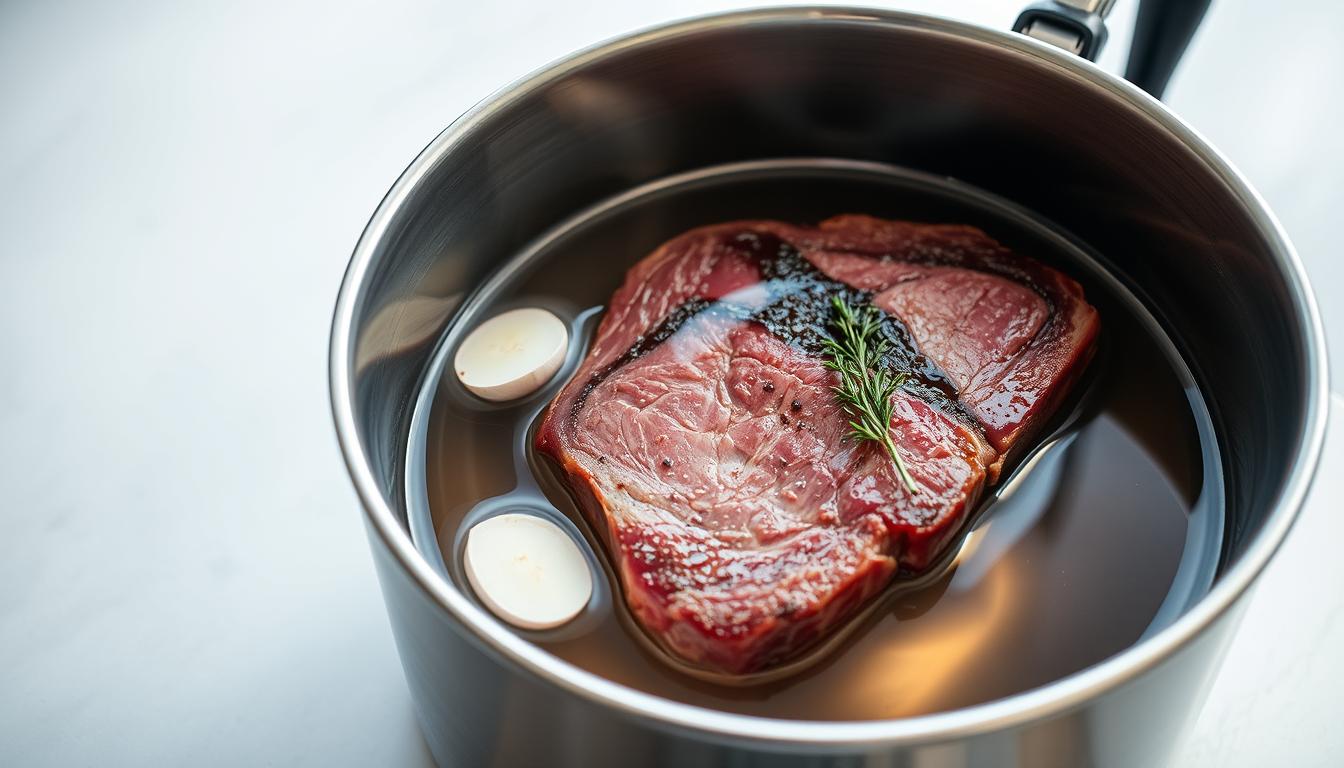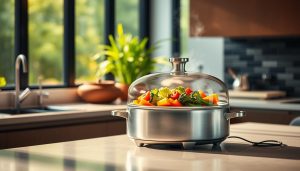Did you know 85% of Michelin-starred kitchens use a water-based cooking technique to achieve flawless meat textures? This approach isn’t just for chefs—it’s now accessible to home cooks, too. By maintaining exact temperatures, it ensures your dish reaches the ideal doneness every single time, without constant monitoring or guesswork.
The secret lies in a method that immerses food in a temperature-controlled water bath. Unlike traditional stovetop or grill methods, this process cooks evenly from edge to edge. No more burnt exteriors or undercooked centers—just consistent results that rival high-end restaurants.
Once exclusive to professional kitchens, this technique has become a game-changer for home enthusiasts. It transforms complex cooking into a stress-free experience. You set the desired temperature, and the science handles the rest, preserving moisture and flavor like never before.
Key Takeaways
- Professional-grade temperature control ensures uniform doneness across the entire cut.
- Eliminates common frustrations like overcooking or uneven results.
- Delivers restaurant-quality outcomes in home kitchens with minimal effort.
- Relies on a scientific approach to maintain exact water bath conditions.
- Simplifies the cooking process, making it accessible to all skill levels.
Understanding the Sous Vide Cooking Method
Ever wonder how top chefs nail meat perfection night after night? The answer lies in a kitchen innovation that uses temperature-regulated water to transform proteins. Food gets sealed in airtight bags and submerged in heated water for exact results.

Science Meets Consistency
Traditional methods like grilling often create uneven textures. Hot spots and timing errors leave some areas overdone while others stay undercooked. The water-based approach maintains steady heat circulation, breaking down connective tissues without zapping moisture.
Why It Outperforms Old-School Approaches
Pan-searing relies on constant attention to prevent burning. With this modern method, you set your desired doneness and let the equipment handle the rest. Juices stay locked in, producing tender results that standard techniques struggle to match.
One restaurant owner notes: “Our customers can’t believe how consistently juicy every cut arrives.” This reliability stems from eliminating guesswork – the water never gets hotter than your chosen setting.
Essential Equipment and Tools for Sous Vide Steak
Achieving restaurant-quality results at home starts with selecting the proper equipment. While the technique sounds high-tech, you likely own most items already. The core components focus on temperature precision and reliable sealing methods.

Sous Vide Cooker and Temperature Control
The immersion circulator acts as your kitchen’s new MVP. This compact device clips onto any heat-safe container, maintaining water within 0.5°F of your target. Models under $100 offer professional accuracy, eliminating guesswork for first-time users.
Consistent circulation prevents cold spots, ensuring even cooking from edge to edge. Unlike ovens or stovetops, there’s no risk of overcooking—set your desired doneness and walk away.
Selecting Your Container and Bags
Your water bath vessel matters more than you think. A 12-quart plastic bin works well, but large pots or coolers also succeed. Depth matters: ensure your cooker fully submerges while allowing water flow around the food.
For sealing, vacuum bags provide optimal contact with the water bath. However, standard freezer bags work using the water displacement trick: lower the open bag into water until air escapes, then seal. This low-cost hack delivers near-perfect results without specialized gear.
Keep tongs nearby for handling hot packages, and always pat meat dry before searing. With these tools, you’ll unlock textures and flavors that rival any steakhouse plate.
Choosing the Right Cut of Steak
Not all steaks perform equally in water-based cooking. Selecting the proper cut determines whether you get good results or restaurant-worthy excellence. The method’s low-temperature approach amplifies each cut’s natural qualities, making texture and marbling critical factors.

Prime Candidates for Precision Cooking
New York strip shines in this environment due to its balanced fat content. Our tests revealed ½-pound portions retained exceptional juiciness after cooking. Ribeye’s marbling becomes its superpower – the fat renders evenly without overcooking the meat.
Filet mignon benefits from gentle heat that preserves its delicate structure. Thicker cuts like 1.5-inch T-bones outperformed thinner options, developing richer flavors during extended cooking times.
Size and Quality Matter
Always choose cuts at least 1 inch thick. Thinner steaks overcook easily, while 2-inch slabs allow perfect temperature penetration. Look for visible marbling – those white streaks melt during cooking, creating buttery textures.
| Cut | Ideal Thickness | Marbling Level | Cook Time Range |
|---|---|---|---|
| New York Strip | 1.5″ | Moderate | 2-4 hours |
| Ribeye | 1.25″ | High | 2.5-3.5 hours |
| Filet Mignon | 2″ | Low | 1-2 hours |
Avoid supermarket discounts with uneven fat distribution. Premium grades like USDA Choice or Prime deliver superior results. As one butcher advises: “Treat your meat like jewelry – inspect every angle before buying.”
Preparing Your Steak for Sous Vide Cooking
What separates a good meal from an unforgettable one? The answer lies in how you prep before the cooking begins. Proper seasoning and airtight packaging create the foundation for flavor-packed results that stay juicy from edge to edge.

Building Layers of Flavor
Start with coarse sea salt – its larger crystals cling better to meat than fine table salt. Pair it with freshly cracked black pepper for a balanced base. One chef explains: “These textures create micro-pockets that trap juices during cooking.”
Add rosemary or thyme sprigs directly to your bag. Herbs release oils gradually in the warm environment, infusing the steak without overpowering it. A pat of butter melts into a rich glaze, basting the meat continuously as it cooks.
Secrets to Air-Free Packaging
Use the water displacement trick for budget-friendly sealing:
- Place seasoned steak in a freezer-safe bag
- Lower it into water until air rises to the top
- Seal quickly before water enters
For stubborn air pockets, try the straw method. Suck out remaining oxygen through a drinking straw while closing the bag. Always use separate bags for different cuts – this prevents flavor mixing and ensures even heat distribution.
Remember: Tight seals keep water out while letting heat penetrate. Test your closure by gently squeezing the bag – if bubbles escape, reseal it. With these steps, you’ll lock in every drop of flavor your seasoning creates.
Setting Up Your Water Bath and Temperature
Mastering your setup transforms ordinary meals into culinary triumphs. The water bath acts as your flavor guardian, maintaining exact conditions for texture development. Proper preparation here ensures your protein reaches its full potential without guesswork.

Temperature Guidelines for Desired Doneness
Control begins with understanding heat levels. Set your circulator 5°F below target doneness to account for post-searing carryover cooking. This prevents overshooting during the final crust creation.
| Doneness | Water Bath Range | Final Internal Temp |
|---|---|---|
| Rare | 120-125°F | 125-130°F |
| Medium-Rare | 129-135°F | 134-140°F |
| Medium | 135-150°F | 140-155°F |
| Well-Done | 156-160°F | 161-165°F |
Adjusting Time For Different Cuts
Thickness dictates duration. Thin 1-inch cuts need 90 minutes to tenderize, while 2-inch slabs benefit from 2.5 hours. Extended 4-hour sessions work wonders for tougher fibers without drying meat.
Always preheat your container to the target temperature before adding bags. Maintain water levels above your cooker’s minimum line using heat-safe weights if needed. One pitmaster notes: “Consistency comes from respecting both time and thermal equilibrium.”
Sous Vide: Precise Heat, Perfect Steak
Imagine hosting a dinner party where every steak reaches the table at peak perfection. This cooking technique turns that vision into reality through scientific temperature management. Unlike traditional methods, your meat stays submerged in water set to your exact desired doneness.
The process requires minimal effort once you start the timer. Season your cuts, seal them in bags, and let the water bath work its magic. You’ll gain hours to prep sides or relax while proteins cook undisturbed.
Multiple steaks cook simultaneously without quality loss. Whether preparing two portions or ten, each piece receives identical heat exposure. A chef instructor explains: “This method eliminates the panic of timing multiple cuts on a grill.”
| Cook Duration | Texture Outcome | Best For |
|---|---|---|
| 1-2 hours | Firm, steakhouse bite | Quick meals |
| 2-3 hours | Buttery tenderness | Special occasions |
| 3-4 hours | Melt-in-mouth softness | Tough cuts |
Overcooking becomes nearly impossible since the water never exceeds your set temperature. However, exceeding four hours breaks down muscle fibers, creating an overly soft texture. Stick to the 2-4 hour sweet spot for ideal results.
This approach revolutionizes meal prep. Cook batches in advance, then quickly sear before serving. You’ll achieve uniform doneness across all cuts—no more guessing games or temperature probes.
Executing the Cooking Process
Transforming raw ingredients into restaurant-worthy dishes requires precise execution. Follow these guidelines to maintain control over every stage while letting the equipment handle heavy lifting.
Step-by-Step Guide to Cooking Your Steak
Begin by filling your container with warm tap water. Attach your cooker and set it 5°F below your target doneness. Once stabilized, gently lower sealed bags into the bath using kitchen tongs.
Cook 1.5-inch steaks for 2.5 hours to achieve balanced tenderness. Thicker cuts may need up to 4 hours for optimal texture. Set phone reminders if multitasking – consistency depends on timing accuracy.
Monitoring Time and Water Levels
Check water levels every 45 minutes. Evaporation occurs faster in open containers. Add hot water as needed, maintaining at least 1 inch above food surfaces.
When time expires, remove bags carefully. Don’t worry about the grayish color – this normalizes during searing. Pat meat dry thoroughly before applying high heat for crust formation.
Remember: proper execution here ensures your efforts shine through. Follow these steps precisely, and you’ll unlock flavors that make every minute count.



